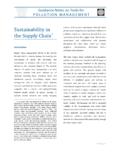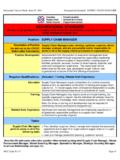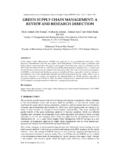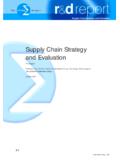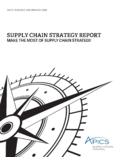Transcription of Building Agri Supply Chains: Issues and Guidelines
1 Building agri Supply Chains: Issues and Guidelines Jan van Roekel, Director, agri chain Competence center Ronald Kopicki, World Bank, Supply chain Advisor Carry Broekmans, agri chain Competence center Dave M. Boselie, Wageningen UR - Agricultural Economics Research Institute (LEI) Abstract: Integrated Supply chains are one of the most powerful competitive tools in today's globalizing business economy. For agricultural products, successful Supply chain development projects reduce not only the transaction costs but also the institutional barriers that decouple individual links in traditional distribution channels. They allow participants to achieve higher levels of service and to capture substantial added value thereby serving as leverage points both for economic growth and for poverty alleviation.
2 This paper also draws on the experience of the agri - chain Competence Center to discuss the critical Issues and step-by-step actions necessary to stimulate and support the emergence of Supply chains in developing countries. I. Introduction to Supply Chains Supply chains are complex entities that serve many functions. They are institutional arrangements that link producers, processors, marketers and distributors. Supply chains are forms of industrial organization which allow buyers and sellers who are separated by time and space to progressively add and accumulate value as products pass form one member of the chain to the next (Hughes, 1994, Fearne, 1996, Handfield and Nichols, 1999).
3 Supply chains are the conduits through which (cf. Cooper et al., 1997): products move from producers to consumers; payments, credit and working capital move from consumers to producers; technology and advanced techniques are disseminated among producers, packagers and processors; ownership rights pass from producers to processors and ultimately to marketers; information on current customer demand and on retail level product preferences pass back from retailers to producers. agri - Supply chains are also economic systems which distribute benefits and which apportion risks among participants. Thus, Supply chains enforce internal mechanisms and develop chain wide incentives for assuring the timely performance of production and delivery commitments (Iyer & Bergen, 1997, Lambert and Cooper, 2000).
4 They are linked and interconnected by virtue of shared information and reciprocal scheduling, product quality assurances and transaction volume commitments. Process linkages add value to agricultural products and require individual participants to co-ordinate their activities as a continuous improvement process. Costs incurred in one link in the chain are determined in significant measure by actions taken or not taken at other links in the chain . Extensive pre-planning and co-ordination are required up and down the entire chain to effect key control processes such as forecasting, purchase scheduling, manufacturing programming, sales promotion, and new market and product launches.
5 The advantages for Supply chain members Individual suppliers, producers and marketers who are associated through a Supply chain coordinate their value creating activities with one another and in the process create greater value than they can when they operate independently. Motives for collaboration between Supply chain participants have been elaborated in detail (cf. Mahoney, 1992, Giupero & Brand, 1996, Gattorna, 1998). Supply chains create synergies in one of three ways: i) they expand traditional markets beyond their original boundaries and thus increase sales volume for members; ii) they reduce the delivered cost of products below the cost of competing chains and thus increase the gross margin for the working capital committed by members of the chain ; and iii) they target specific market segments with specific products and they differentiate the service, product quality or brand reputation of the products they deliver to these market segments and thus increase consumer perception of delivered value.
6 In this way, they allow chain members to charge higher prices. Generally, however, Supply chains increase market contestability both at the producer end and at the consumer ends of the chain . At the consumer end, chains compete primarily through price, differentiated products and services and differentiated terms of sale. At the producer end of the chain , Supply chains compete with one another primarily for "producer affiliation" and core vendor commitments. "Producer affiliation" implies a long-term relationship between producers and other members of the chain based on process integration, stability in Supply , and greater investment in efficient integration into the chain .
7 Rather than unaffiliated "arms length transactions", Supply chains substitute intra corporate, contractual or franchise affiliation thereby enabling them to transfer risks among participants in the chain . In this way, supplies chains effect and progressively increase comparative advantage based on specialization among chain partners. Many producers in developing countries can benefit by joining Supply chains. Indeed only through chain affiliation can many producers determine whether they will target their production for upscale, product differentiated markets or down scale, commodity markets. Agile and innovative agri - Supply chains allow producers to improve their gross margins, increase their savings from cash crop sales and adapt their products, value adding processes and channel alignment to dynamic market circumstances.
8 Competition among chains for the best producers allows producers to rise above a price taking relationship and to affiliate strategically with chains. The forms of association among Supply chain partners are various and may include corporate affiliation, contractual affiliation, membership in a trading community, membership in a producers cooperative, etc. Well-designed Supply chains are capable of realizing several kinds of captured value for their participants. For example, they assure: i) through quality control that exacting product requirements ( eco certification) of retail customers can be met or exceeded in each step within the chain , ii) through innovation in product, in production/ distribution processes and in chain alignment that individual chains compete successfully with other chains based on superior product quality, price-to-value, value-to-cost and, importantly, logistics innovation and that the chain itself continuously adapts in its design, component competencies and market feedback systems to dynamic market requirements.
9 Iii) through the compression of the order-to-delivery cycle, improved demand forecasting, quicker Supply response and strongest link financing of the entire chain that working capital required to produce and deliver marketable products to end consumers is minimized, iv) through risk management that production/ delivery/ sale risks are allocated efficiently both among chain participants based on their capacity to manage specific risks and to third parties when chain participants cannot effectively manage specific risks; v) through competitive chain management that the value premises which underlie the chain s design are continuously tested, validated and adapted to changing circumstances.
10 The impact of agri Supply chain affiliation Customer oriented cross-border agri Supply chains have an enormous reciprocal effect on each of the successive companies involved in the chain . The following lessons can be learned from successfully implemented agri Supply chain projects: - Long term relationships between partners in the chain , lead to improved margins and improved market knowledge for the primary producers (growers and farmers); - Reduction of product losses during storage and transportation, result from optimal co-ordination of the successive activities in the chain ; - Quality and /or freshness of products can be improved greatly; - Improved safety of food products can be assured; - Sales can be increased significantly, due to exchanging market information.











